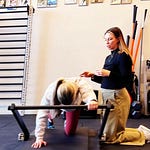Most people think muscles fail during isometrics because they run out of oxygen. They don’t—they fail because of how carbon dioxide (CO₂) builds up when breathing is restricted under load.
Breathing is the most fundamental rhythm of human life. We take more than 20,000 breaths each day, and while the act is automatic, the way we breathe directly influences our health, performance, and resilience. Breath work—the conscious regulation of respiration—plays a critical role in optimizing muscle endurance, cardiovascular efficiency, and long-term vitality. Nowhere is this more evident than in isometric strength training, where the interaction between breathing and muscular tension can determine both immediate performance and long-term health outcomes.
Isometric muscle actions can be performed in two primary ways. In pushing or pulling isometric muscle actions (PIMA), the individual initiates the force by pressing or pulling against an immovable resistance. In holding isometric muscle actions (HIMA), the individual resists an external load, maintaining position against the force of gravity or another object. While both are technically isometric, their effects on breath control and endurance differ in important ways.
Research shows that during both HIMA and PIMA, muscle oxygenation remains surprisingly stable. Local venous oxygen saturation (SvO₂) tends to level off into steady states, and capillary blood filling (rHb) is maintained through natural oscillations within the muscle fibers. In other words, oxygen delivery to the muscle does not collapse during sustained isometric contractions. This challenges the assumption that fatigue in isometrics comes from oxygen starvation. Instead, endurance—measured as time to task failure (TTF)—is heavily influenced by breathing strategy and the buildup of CO₂.
When breath is held or restricted, oxygen delivery to the muscle remains fairly stable, but CO₂ clearance is impaired. Rising CO₂ increases blood acidity (lower pH), creating the urge to breathe and contributing to discomfort. The intramuscular pressure of isometric contractions compresses blood vessels, slowing the removal of CO₂ even further. The nervous system interprets this accumulation as a critical stressor—meaning the “need to breathe” is driven more by CO₂ buildup than oxygen depletion.
The differences emerge in how the body handles breath during each modality. PIMA, being proactive, allows for greater synchronization between muscle contraction and breath control. Athletes can deliberately brace with a breath hold (Valsalva maneuver) or use structured exhalations to regulate internal pressure. This stability supports longer performance durations in many cases, as the nervous system can pair anticipatory drive with intentional breathing patterns.
Side note: During both PIMA and HIMA, we highly recommend breathing. While brief breath-holds may be used for bracing, prolonged breath-holding dramatically elevates blood pressure and cardiovascular risk. In HIMA especially, the tendency to unconsciously hold the breath is even greater because of the reactive nature of the contraction. Whether proactive or reactive, the performance gain from holding the breath is not worth the health risk—controlled breathing strategies are always the safer and more effective choice.
HIMA, by contrast, is reactive. Because the body is resisting an external load, subtle oscillations occur at the joint and muscle level. These small variations disrupt rhythm and often lead to irregular or restricted breathing. The cardiovascular system may be challenged more quickly, and the tendency to unconsciously hold the breath is greater. This can shorten endurance even though oxygenation at the muscle remains stable. In effect, it is the CO₂ buildup—not the oxygen supply—that becomes the limiting factor.
Interestingly, studies have shown that introducing small, intermittent twitches during HIMA can extend endurance. These brief contractions provide a micro-reset for both neuromuscular control and breathing rhythm. While oxygenation variables remain unchanged, the improved time to task failure highlights how even small adjustments in movement and breath can delay fatigue. This reinforces the point that breath regulation is central to sustaining isometric performance.
Leaders in high-performance sport have already recognized the value of training breath under isometric load. Andrew Hauser, former World Series medical director of the LA Dodgers, often combines the Isophit Strength Kit with the ISOCAPNIC training device to integrate muscular force production and respiratory control. By pairing isometrics with a system that challenges breathing mechanics, athletes are taught not just to generate force, but to sustain it under controlled respiration—an approach that enhances both performance and long-term resilience.
From a broader health perspective, this integration has clear implications. Chronic breath-holding under load elevates blood pressure and increases cardiovascular strain, while rhythmic, controlled breathing lowers physiological stress. Over time, practicing intentional breath control during isometric exercise can reduce hypertension, improve recovery, and build resilience against both physical and emotional stress. For athletes, it translates into longer, steadier force production. For aging populations, it means climbing stairs or carrying groceries without becoming breathless.
Ultimately, isometric training is not just about muscles—it is about breath. By learning to coordinate respiration during both PIMA and HIMA, and by using tools such as the Isophit Strength Kit and ISOCAPNIC devices in combination, individuals train the body to stabilize under pressure, manage cardiovascular load, and extend endurance. Breath work transforms isometric exercise from a test of tension into a practice of respiratory resilience. Over the course of a lifetime, this integration of breathing and isometric force production is not just a performance advantage—it is a foundation for longevity.
At Isophit, we help the world’s strongest, fastest, and most dominant athletes—and everyday people—to win more, hurt less, and age stronger!
Visit www.isophit.com and join Team Isophit today.







